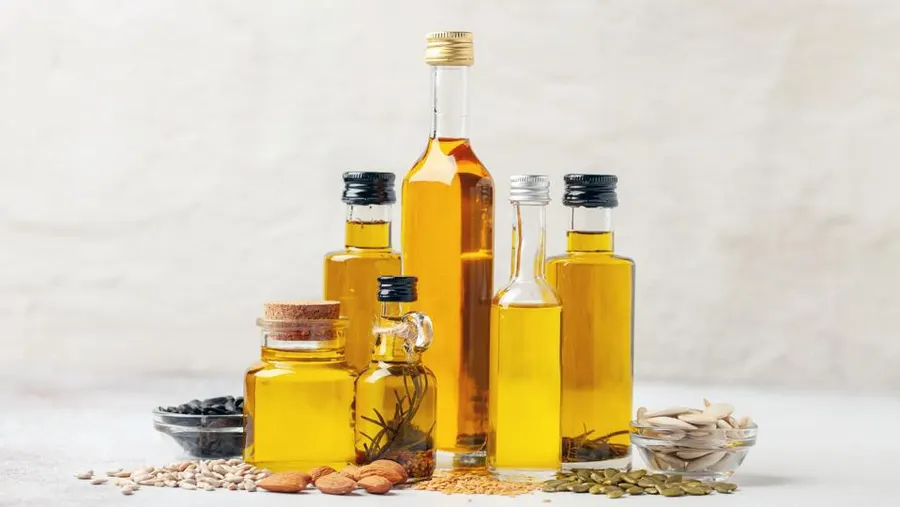Think you know which oil to use when, and how? Think again. Food aficionados like to boast that their unfiltered, extra-virgin olive oil is sacred, only for drizzling over radicchio, and that flaxseed oil is the nutrient booster to use when sautéing aubergines. Wrong.
Oil is a kitchen hero, of course. Its uses are endless, from making those salad leaves glisten and turning sizzling fishcakes an even golden brown, to giving carrot cake the most enticing damp, rich texture.
Until a decade ago, the choice for cooking was olive oil, corn or sunflower, but recent years have seen a boom in alternative oils. There’s cold-pressed rapeseed, walnut, or those darlings of the clean-eating-and-never-mind-the-food-miles brigade, coconut and avocado oil.
Liquid oils are mostly low in saturated fat and high in more healthy unsaturated fat, including monounsaturated fat (such as omega-9) and polyunsaturated fat. Polyunsaturated fats are made up chiefly from omega-3 and omega-6 fats, and a ratio of 1:1 in our diets is ideal. We tend to eat too much omega-6, so it makes sense to seek out fats higher in omega-3, which are essential for brain health.
But what about the olive oil boast? While recipe books often insist on ‘ordinary not extra-virgin’ for frying, that harks back to the days when there was a first and second pressing of olives to produce different grades. Nowadays pretty much all olive oil is centrifugally extracted, and the ‘extra-virgin’ refers not to first press but to approved acidity levels and expert grading.
The light-coloured olive oils in the supermarket, not labelled ‘extra-virgin’, are heavily processed. So for a gentle sizzle, extra-virgin is fine. British rapeseed oil is better for higher heat, like a crackling, spitting stir-fry.
These bog-standard oils such as sunflower (best used for deep-frying), in their ridged, square plastic bottles – including the vaguely labelled supermarket ‘vegetable oil’, which may be a blend, probably of whatever is cheapest on the market at the time – are known in the trade as RBD: refined, bleached and deodorised oils.
RBD oil is extracted from the seeds or fruit using a combination of heat, pressing and a solvent called hexane. It may then have the alkali caustic soda added to ‘neutralise’ any acid, forming a soap which is then washed away, as is any residual hexane. The oil is acid-treated to strip out impurities (as well as some of the beneficial micronutrients) and steam-treated to remove any unpleasant smell. Because none – or only vestigial amounts – of any of the additives used remain in the finished oil, none need to be listed on the ingredients label.

None of which is especially appetising, but it is expedient for the manufacturer. The process makes the oils bland (appealing to customers) and gives them a long shelf life, which suits retailers. It also gives them a high ‘smoke point’ (see previous page).
A final note: the way you store oil is important. Taking a sniff from that expensive bottle of nut oil to find it has gone rancid already is infuriating – but most of us just don’t use them up fast enough, and nut and seed oils (except sunflower oil) can ‘turn’ in a couple of weeks, especially if you keep them in a warm spot by the cooker. Keep them chilled and they’ll last years – I’ve got a shelf in the fridge door reserved for posh nut oils.
A good compromise: keep a small bottle (ideally pottery not glass or metal) within arm’s reach, and refill it as necessary from a bottle kept in a cool cupboard.
The Rundown: What To Use And When To Use It
Coconut Oil
Good for vegan baking as it is solid, like butter, at room temperature. But it’s nearly all saturated fat, and has no omega-3.
- Monounsaturated: 6%
- Polyunsaturated: 2%
- Saturated: 92%
- Omega-3: negligible
Extra-virgin Olive Oil
Use for salad dressings and drizzling over finished dishes. The fairly low smoke point means it’s not great for searing meat and vegetables or roasting meat.
- Monounsaturated: 78%
- Polyunsaturated: 8%
- Saturated: 14%
- Omega-6/3 ratio: 13:1
Sunflower Oil
Works for general frying and as a base for dressings and mayonnaise. Look out for high-oleic sunflower oil (made from particular varieties) with more omega-3.
- Monounsaturated: 20%
- Polyunsaturated: 69%
- Saturated: 11%
- Omega-6/3: ratio 40:1
Rapeseed Oil (aka canola oil, in the US)
Good unrefined, cold-extracted oil is nice for salad dressings and gentle braising, such as courgettes. Refined rapeseed oil has lower micronutrient content.
- Monounsaturated: 62%
- Polyunsaturated: 31%
- Saturated: 7%
- Omega-6/3: ratio 2:1
Groundnut Oil (aka peanut oil)
High in vitamin E and good for frying – fish, for example. Generally highly refined but the unrefined oil has a pronounced nutty flavour.
- Monounsaturated: 48%
- Polyunsaturated: 34%
- Saturated: 18%
- Omega-6/3: ratio 32:1
Avocado Oil
Use for salad dressings and stir-fries. It’s very bland so won’t overpower delicate flavours, and contains vitamin E.
- Monounsaturated: 70%
- Polyunsaturated: 14%
- Saturated: 16%
- Omega-6/3: ratio 13:1
Flaxseed Oil
Good for adding to cereal and smoothies to boost omega-3 levels for non-fish-eaters, but it has a fishy smell. Not for cooking as it has a very low smoke point.
- Monounsaturated: 62%
- Polyunsaturated: 31%
- Saturated: 7%
- Omega-6/3: ratio 2:1
Walnut Oil
Add to salad dressings and coffee and walnut cake (keep the oven temperature below 160C), but it goes rancid quickly at room temperature.
- Monounsaturated: 24%
- Polyunsaturated: 67%
- Saturated: 9%
- Omega-6/3: ratio 5:1

